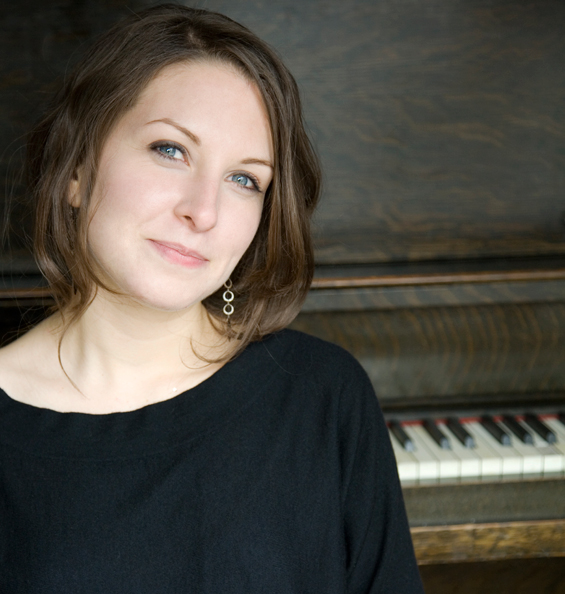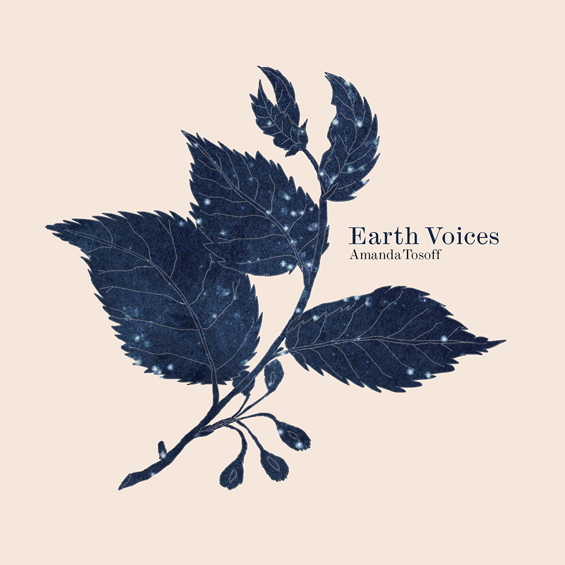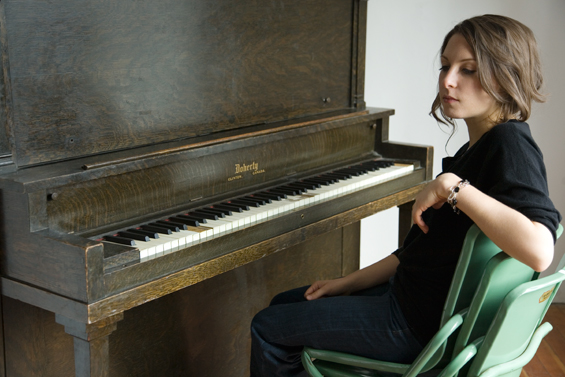

photo: Angela Fama
FIVE QUESTIONS WITH AMANDA TOSOFF
Earth Voices, the sixth album by British Columbia-raised and Toronto-based pianist Amanda Tosoff, represents a dramatic next stage in her artistic evolution. After receiving accolades and a Juno nomination for 2016's Words, which features Felicity Williams giving remarkable voice to Tosoff's genre-transcending blend of jazz, art-song, and folk-pop, she's expanded on its vision by adding six more vocalists to Williams for the follow-up. The release (reviewed here) is significant for other reasons, too: originals by Tosoff appear alongside covers of songs by Joni Mitchell, Luciana Souza, and others; literary greats such as Poe, Neruda, and Whitman are drawn upon for lyrics; and seventeen musicians in total contribute to the album's expansive soundworld. textura spoke recently with Tosoff about Earth Voices and how it all came together.
1. The creation of Earth Voices obviously involved an extraordinary amount of time, effort, and logistical planning: in terms of personnel, seven rotating vocalists appear, and the core piano trio is augmented by (on different tracks) guitarist Alex Goodman, saxophonists Allison Au and Kelly Jefferson, and string players. Recording involved nine studio sessions, and for your compositions you drew for lyrics from the poetry of Poe, Whitman, Rumi, and Marjorie Pickthall. Did you have a crystal-clear vision of what you wanted Earth Voices to be at the outset or did it organically coalesce into its final form as work on it progressed?
It definitely took a lot of planning! With sixteen guest artists—some living abroad and all of them busy with their own schedules—it was definitely tricky to get everyone together to record in one place at one time! Knowing that I'd have to record the band first, then strings, and then most of the voices, I planned the music out much more than I have in the past. This sort of approach to recording worked well because my core group knew the music very well already, but also because this music is more through-composed. Almost all the parts for each instrument/voice were written and worked out in advance, which isn't the norm for most jazz recordings, where the goal is often to capture the performance and improvisations in the moment. But it worked out really well, I think, because I had a clear vision and spent a lot of time imagining how the recording process would go. That said, I must say my special guests surpassed my expectations with amazing performances and many wonderful moments I couldn't have imagined! It's even better than I had envisioned.
2. There are many impressive things about Earth Voices, but one that definitely stands out is how seamlessly you've combined so many elements. While jazz is obviously key, singer-songwriter-like qualities are present and the strings add a classical character. Even better, it's not the case that a song can be sliced into separate pieces—jazz and soul here, folk and singer-songwriter there, etc.; instead, you've blended the parts into sophisticated settings that reconcile all such elements into fluid hybrids. Was this a difficult thing to achieve, or again is it something that happened naturally in the creative process?
Well, thank you first of all! So, this blending of influences started with my previous recording Words, out of which Earth Voices emerged. When I started writing music to poems for the earlier album, it was a really interesting experience. I took these beautiful poems, with built-in phrasing, imagery, and moods, pondered them, then sat at my piano, and tried to come up with a harmony that captured the mood of each poem; I then sang a melody with the opening line of text and then tweaked and played around with that until it sounded like something I'd like to build a piece from. I think that having a poem to start with, coupled with me singing the melody versus playing it on the piano, made me go to different places than I was used to—perhaps something more folk/pop or more song-oriented, even though there are still many modern jazz influences in the music. Interestingly enough, these two records were the first time I wrote from my voice first and without judging or really trying to do something specific with what I was writing, so this blending of influences just came naturally.

3. Given how much your lyrical compositions so perfectly lend themselves to vocal-enhanced treatments, I'm curious as to why it wasn't until your fifth album, 2016's Words, that you decided to feature them?
I've always approached instrumental composition and playing the piano from a vocal approach, even though I don't sing publicly (at least yet!). I sing as I compose and internally as I improvise. I love singable melodies and solos, so I do think, as you say, a vocal approach comes naturally to me.
I hadn't worked with voice prior to Words for a few reasons, one being that I don't know how to write lyrics. So it took me discovering some poetry I liked to push me in that direction. The other reason may be that when I was younger, I had this idea that adding vocals to my band would make my “modern jazz” album less appealing to jazz buffs or that it wouldn't be taken “seriously.” This is of course, a ridiculous idea, but I do think that this sort of thinking has been somewhat common in contemporary jazz, this idea that a vocal album isn't as “serious” or that singers aren't really “musicians,” which I think stems from sexism in the jazz world (not that all singers are female, of course!). Whether people disagree or not with my statement, I will just add that it's sad for me to admit that it's taken me a long time to feel comfortable being a “woman” in jazz, which may be why I haven't brought a female voice (literally!) into my music in the past. However, these days I'm surrounded by some pretty amazing women who have inspired me to “sing out” loud and proud, and I think this comes across on Earth Voices, even if I'm not one of the wonderful vocalists on this album.
4. textura's love for Joni Mitchell is no secret (after all, textura's 2019 label release, Swallowed By the Sky, is a Mitchell tribute) so I was naturally chuffed to see “The Fiddle and the Drum” included as one of the eight pieces. Considering the vastness of her catalogue, what made you choose this song in particular? Has she been a big influence, and who else would you cite as key influences on Earth Voices?
I've always loved Joni's tunes, although I have to admit she hasn't been one of my main influences. I discovered “The Fiddle and the Drum” when I was looking for repertoire to add to my book before embarking on my first tour with my Words Project. I thought that a Joni tune would fit well with my music, so I listened through her catalogue and discovered (for the first time, actually) this piece. It's a completely a cappella melody that is so haunting and powerful, a powerful anti-war song, actually. I was so moved by it that I wanted to cover it so added my own chords and rhythms to it, fleshing it out for my ensemble. Lydia Persaud sings this one and captures that intensity and powerful emotion in Joni's tune.
As far as influences, I'm not sure there are specific ones. I think it's just a big mix of influences over the years, from Debussy, to Oscar Peterson and Bill Evans, to Becca Stevens, and fellow Canadians like Christine Jensen and Brad Turner, whose melody writing has definitely influenced mine.

photo: Angela Fama
5. The impression I get while listening to Earth Voices is that you very deliberately paired the vocalists with the songs on which they appear. Could you say a few words about the singers, the qualities that differentiate them, and how you went about determining that a particular one would be best for a particular song? Could you also comment on the instrumentalists who contributed, among them top-flight musicians such as Au and Goodman who enhance every album on which they appear?
I will first of all say that I love the music of all these artists, so I knew I wanted their voices on this record! I did spend many, many hours imagining who would sing what. For some, it was easy, like Felicity Williams, Lydia Persaud, and Emilie-Claire Barlow, who I've worked with a lot over the years. I was very familiar with their vocal range, tone, stylistic backgrounds, how they naturally phrase and embellish melodies. Take for example, Felicity singing “To a Stranger.” In my mind, this melody needed a voice with a higher range and crystal clear tone, and a voice that was close to my own because of the meaning this song has for me, personally (not that I can sing like Felicity!). She beautifully captured the feeling in this piece and nailed its winding, tricky melody. Another example is Lydia on “The Fiddle and the Drum,” which requires the kind of power and intensity she really brings to the music; her voice is so rich and soulful too! And then there is Emilie-Claire on “Dream Within a Dream” and “Finis.” Her approach to rhythm and her laser-beam precision really makes the melody of “Dream” pop and come across with the intensity and playfulness I was looking for. I also wanted her to sing the solo line I wrote “Finis,” which in fact was written for her voice in mind.
I could go on and on about the songs and the vocal guests, but I'll simply say that all the vocal guests are unique yet also go together so well. There's Robin Dann's clear, unaffected approach and beautiful phrasing on “Sonnet 49,” Alex Samaras's gorgeous rich and dynamic sound in “Birdwings,” Michelle Willis's buttery and folk-influenced vocals on “Here and Heaven,” and Laila Biali's pure, warm sound, which perfectly brings out the emotion of “Oh, Life.”
And as for the instrumentalists, I've played with them a lot over the years. There is Morgan on drums, who can be super sensitive and also bombastic when needed, Jon Maharaj, who is a rock and the heartbeat of the band, Alex Goodman, who always adds the perfect textures on guitar and and a modern flavour to the group as a soloist, and of course, the guest saxophonists Kelly Jefferson, whose power and energy is infectious on “Dream Within a Dream,” and Allison Au, whose gorgeous melodic approach to improvisation was perfect for her solo on “The Fiddle and the Drum.”
Bonus question: As mentioned, the songs draw for lyrics from a number of different writers, from Mitchell and Whitman to Poe, Pablo Neruda, and others. Did you intend for their lyrics to collectively crystallize into an overall theme (and if so, what is it) or is it more the case that you wanted each song to convey its own distinct message?
I didn't go into the project with a theme in mind or consciously choose poems based on their themes, etc. I approached choosing these songs and poems intuitively. These days I really just go with my first reaction and my “gut” as I find that makes for the best music! I can see though that I'm naturally drawn to poetry that has nature imagery and a pensive sort of feeling. I'm also drawn to poems and lyrics that are sad or that speak to loss or the end of life. I actually joke about this sometimes, as I often think people must think I am depressed, but I think I just love using music to feel a tinge of sadness in order to be reminded of the good in life and, in the case of a few of these songs, to remember to fully live. I definitely feel that way with the final song, “Finis,” where Marjorie Pickthall writes about wanting more life as the road nears the end, wanting all that life offers, the love, sorrow, work, play, and everything in between.
website: AMANDA TOSOFFFebruary 2021![]()